Not only does Vientiane win nice comments on Laos’ capital and largest city with a serene atmosphere and laid-back lifestyle, but also on its praiseworthy list of Vientiane tourist attractions. The list comprises significant Buddhist temples, historical monuments, and museums, which give visitors deep insights into Laos’s history, culture, and religion. Located on the banks of the Mekong River, the city has gone through economic growth and become an economic center of Laos. It is home to the most important national monument in Laos that is Pha That Luang, besides other critical Buddhist monuments. What’s more, the city hosts the unique “Arc de Triomphe” of Laos, Patuxai, which serves as the memorial monument including exceptional Lao motifs. Along with that, Vientiane is known for its annual festivals, and the most famous one is “Pi Mai Lao” or “Songkran” (Lao New Year, also known as Laos Water Festival) which takes place around mid-April and lasts for three days. Water splashing is one of the best experiences in the city of Vientiane that welcomes all tourists.
Vientiane city has a history of around 1,000 AD and lies on the curve of the Mekong, which preserves numerous important national monuments of Laos, open to the public. The long history of Buddhism in the city is well-kept in the ancient Buddhist monasteries and temples. While most visitors are keen on exploring local landmarks, the rest might love interacting with the Laotians who pursue a gentle laid-back lifestyle. They are so friendly and generous which contributes to the good reputation of Laos tourism, making it a favorite country in Indochina. Vientiane also has a night market filled with authentic Laos identical products and souvenirs for an awesome nightlife experience. Traveling to Vientiane is the first step leading you into beautiful Laos. Let’s find out 10 famous tourist attractions of Vientiane in this article.
Pha That Luang
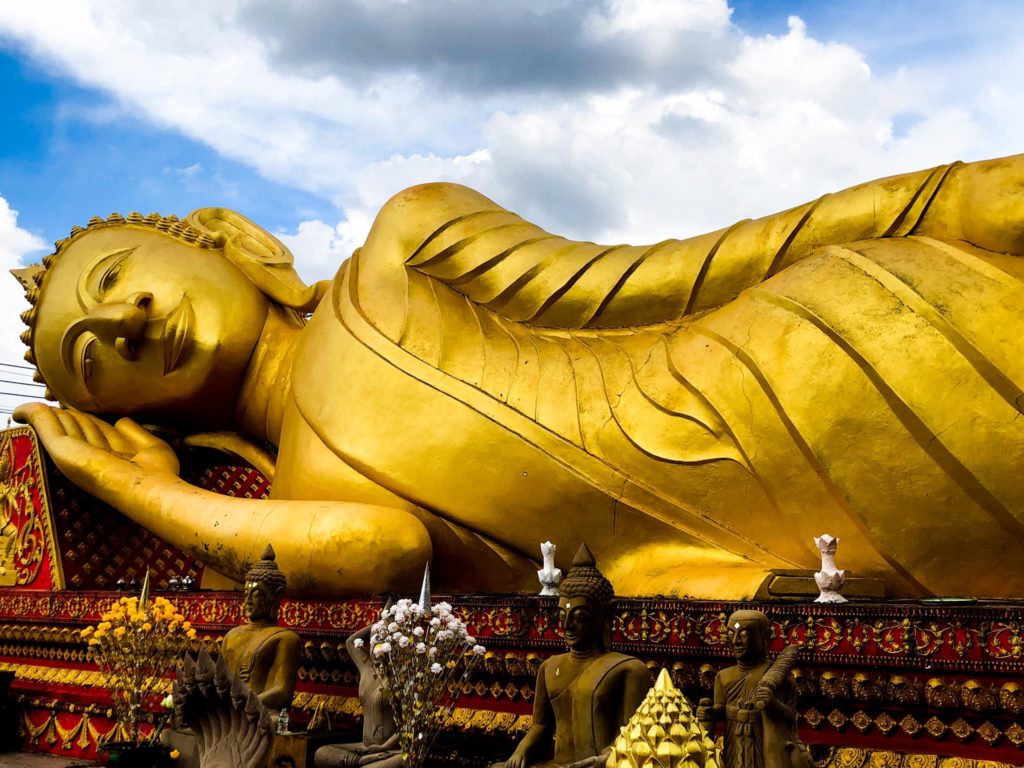
The most famous Vientiane tourist attraction is Pha That Luang. The Great Stupa is a gold-covered immense Buddhist stupa in the heart of Vientiane. This Buddhist monument was supposed to be initially established in the 3rd century CE. In 1566, as King Setthathirath moved his royal capital city from Luang Prabang to Vientiane, he decided to make Pha That Luang an opulent stupa worth his throne. In 1828, the stupa was almost destroyed by the invading Kingdom of Siam and then abandoned for a period. Then, the French rebuilt it modeled on King Setthathirath’s. However, it was again almost destroyed in 1940 during the independence movements of Southeast Asia. After World War II, it was reconstructed into the Great Stupa you see today. Pha That Luang is the most important national monument of Buddhism in Laos and a symbol of the country, printed on banknotes and national emblem. Its architecture reflects Lao culture and identity. From ground to pinnacle, the main stupa has a total height of 44m and is surrounded by auxiliary towers painted in gold color. Legend also said that the stupa preserved a relic of the Buddha, a hair, and a lot of treasures. The center tower is a large block of magnificence rising like an arrow while its base is a square lotus with golden petals blossoming in four directions. On the lotus is a square pedestal with a complicated structure. The entire compound could even illuminate in the evening as being covered in gold leaves.
Patuxai, Vientiane’s own “Arc de Triomphe”
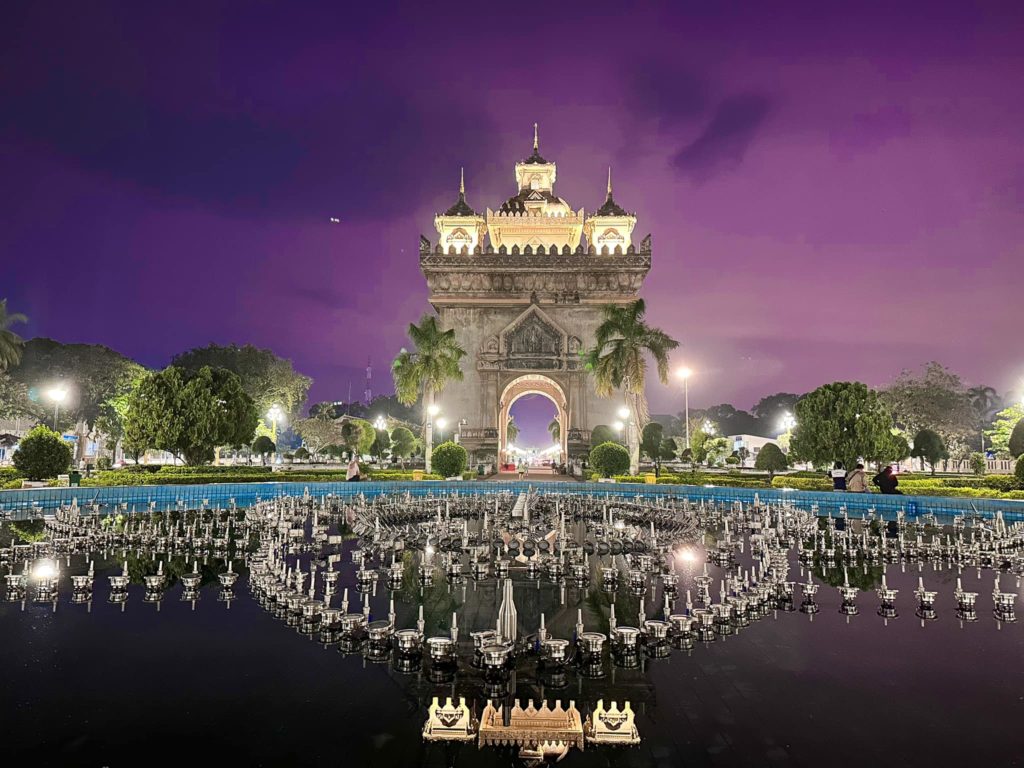
Also known as Victory Gate or Gate of Triumph, Patuxai is a memorial monument at the northeastern end of Lan Xang Avenue. It was constructed between 1957 and 1968 and dedicated to commemorating the Laotian soldiers who died during World War II and the independence war from France in 1946. The construction resembled the “Arc de Triomphe” in Paris, so it is also called Vientiane’s own “Arc de Triomphe”. Nonetheless, the monument has an exceptional Laos motif, which is the nation’s mythological creature, the “kinnari” (half-female, half-bird). Also, it has five towers representing five principles of coexistence among countries of the world. Besides, they are representatives of the five Buddhist principles, which are “thoughtful amiability, flexibility, honesty, honor, and prosperity.” The construction has getaways on four sides oriented to four cardinal directions. Inside, there is a central cloister vault decorated with depictions of Vishnu, Brahma, and Indra gods. Oftentimes, people choose to visit Patuxai Arch in the afternoon, which takes a 5-minute drive from the town area. The 7th floor on the top of the building offers an excellent view of the city. It is super easy to visit the Gate of Triumph as all tuk-tuk drivers know this famous site and it’s not far from the city center.
Wat Si Muang
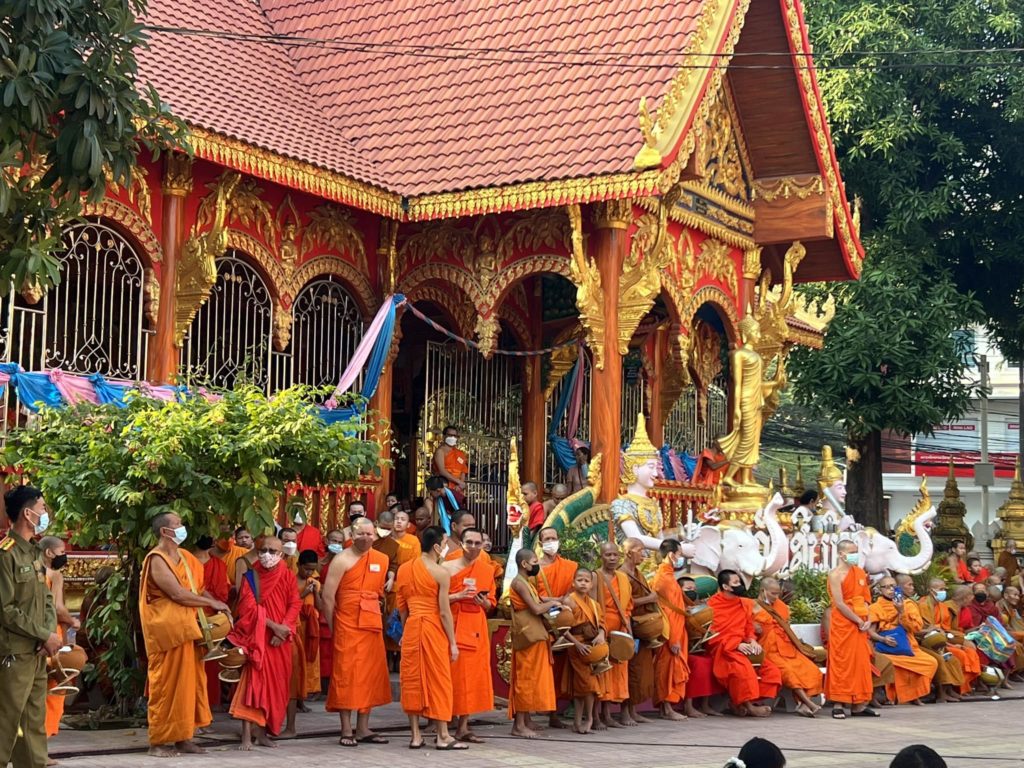
Wat Si Muang is a well-known Buddhist temple and one of the best temples to see in Vientiane. It was erected in 1563 under the reign of King Setthathirath. The temple was named after a young woman, Si Muang, who sacrificed herself to appease angry spirits. She jumped into a hole in the ground in which the central pillar of the hall was to be placed. Nowadays, its architecture is divided into two halls. While the front hall is quiet, the rear hall houses many statues and images of the Buddha on the large altar. With a long history, Wat Si Muang is among the most consecrated Buddhist sites in Laos and is considered the home of the guardian spirits of Vientiane. It is also referred to as the “mother temple” of all temples in Vientiane. It’s frequently visited by the locals who bring incense, candles, and offerings to worship and pray for good fortune. While serving the local Buddhist community, the temple provides deep insights into the Laotians’ spiritual life, and there are good chances to see how they practice their religions. At the entrance of this Vientiane tourist site, there are stalls selling offerings like bananas, flowers, coconuts, incense, and candles. Wat Si Muang is surely a must-see point in Laos Tours.
Wat Si Saket
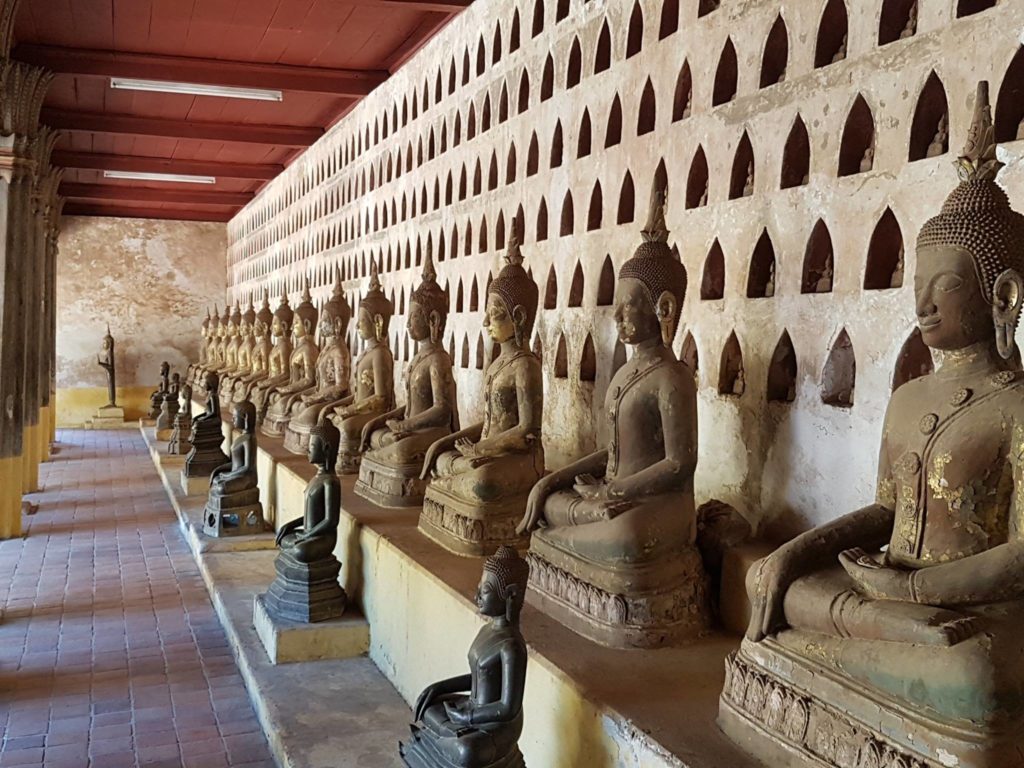
Located on Lan Xang Avenue, Wat Si Saket is a significant Buddhist temple to visit during a Vientiane city tour. The temple was said to formerly held the Emerald Buddha statue. And it was originally built in 1818 at the behest of King Anouvong (Setthathirath V) in the Siamese style of Buddhist architecture featuring a surrounding terrace and a five-tired roof. That said, Wat Si Saket is the oldest temple in Vientiane, going through two times of restorations in 1924 and 1930. Its highlights nowadays include a cloister wall with over 2,000 ceramic, silver Buddha statues of varying sizes and styles, and a museum inside. Visiting Wat Si Saket, make sure you observe the ornate 5-tiered roof, the drum tower, and the library with the Burmese-style roof. What’s more, Buddhist sculptures in this ancient Wat were made between the 16th and 18th centuries. The best time to visit this temple is the early morning when you can meet many Laotians praying and making offerings and merit to the monks.
Haw Phra Kaew

Haw Phra Kaew or Wat Ho Phra Keo is a Buddhist temple located on Setthathirath Road, to the southeast of Wat Si Saket. The temple was initially constructed in 1565 to house the sacred Emerald Buddha at the behest of King Setthathirath. It served as the King’s personal place of worship; therefore, there were no resident monks at this place. The Emerald Buddha was housed in the temple for more than 200 years. However, in 1779, it was taken by the Siamese and the temple was destroyed. The Emerald Buddha now is kept in Wat Phra Kaew in Bangkok, Thailand. Going thru the ups and downs of history, Haw Phra Kaew has been rebuilt several times. Nowadays, the site houses a museum of religious art and is open to the public. So now, it is used as a museum rather than a place of worship. There, visitors find some classical examples of Laos religious art exhibitions. There is a number of stone Buddha statues of the 6th – 9th centuries on the terrace beside the bronze standing and seated Buddha statues.
Buddha Park
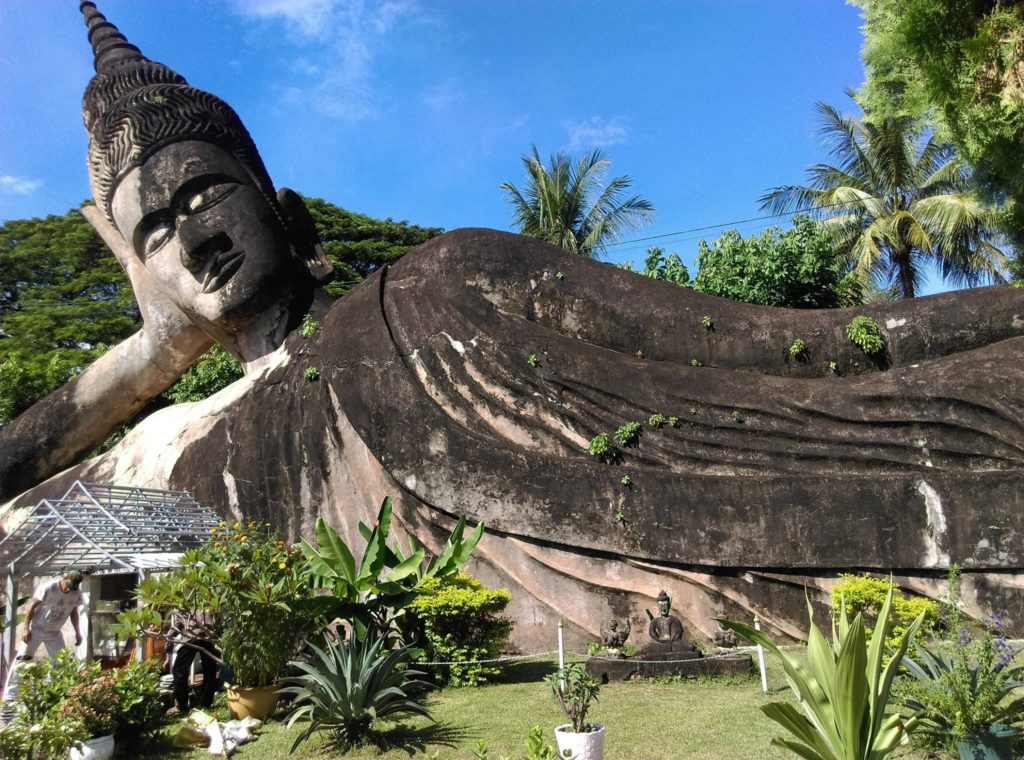
Buddha Park, also called Xieng Khuan (meaning Spirit City), is a sculpture park, around 25km southeast of Vientiane. It was started in 1958 by Luang Pu (Venerable Grandfather) Bunleua Sulilat who integrated Buddhism and Hinduism. There are more than 200 Hindu and Buddhist statues made of concrete in the Park for worshipping and sightseeing. Housing numerous religious images and statues of humans, gods, demons, and animals, the Buddha Park functions as one of the most special tourist attractions in Vientiane. It’s visible to find various sculptures of Buddha and characters of Hindu lore in the area. The statues and sculptures appear to be century-old, though they are not. One outstanding sculpture resembles a giant pumpkin with three stories (representing Hell, Earth, and Heaven). People can enter it via the mouth of the 3m-tall demon head as an opening. Then, climb the staircases of the three stories (from hell to heaven). Each story has sculptures depicting its level. On the top of the sculpture is a vantage point for viewing the entire park. Another notable site is an immense 40m-long reclining Buddha statue. Being full of Hindu and Buddhist statues, this park is an ideal quiet place for reflection. It is the unique concrete sculpture park in the world that you must see to believe.
Lao Textile Museum

Exploring Laos thru textiles becomes an interesting journey just in the Lao Textile Museum. The country has been known for unique silk woven items, skilled workmanship, and complex weaving techniques, which are all well exhibited in the museum. Besides, the exquisite fabrics and natural dyes are remarkable traits. Through weaving, the Laotians depict their lifestyle, environmental and spiritual beliefs, and local knowledge. Any questions about the Lao’s textile history and quintessence could be answered in the dedicated museum, so it is undoubtedly a praiseworthy site to visit. The Lao Textile Museum is the first private museum established in Laos and it exhibits antique items of silk produced by different ethnic groups. The site is set amid peaceful surroundings and a flower garden, which is also photogenic. Together with the valuable exhibitions of silk woven products, the museum offers activities for visitors to try natural dyeing, enjoy butterfly pea tea, and buy souvenirs at the workshops. The souvenir shops sell a wide range of traditional silk weavings, textiles, clothing, and hand-woven fabrics. The designs are said to be original and exclusive.
Lao National Museum
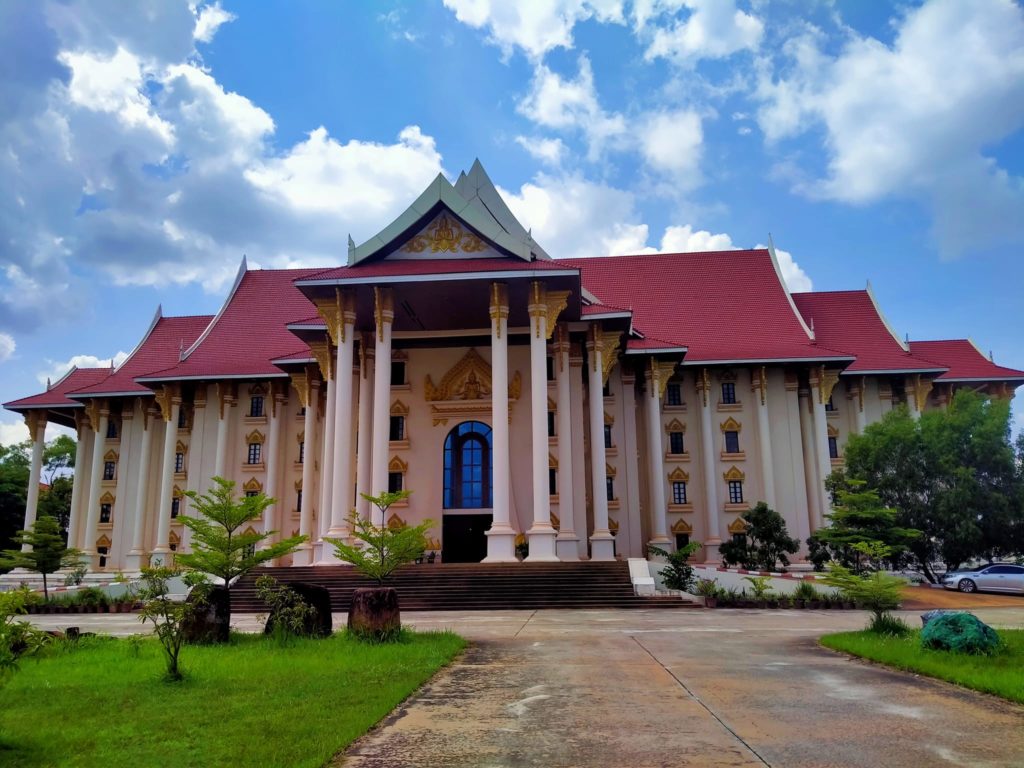
Founded in 1925, the Lao National Museum was originally used as the French governor’s residence. The museum is in a French colonial building, preserving the history of Laos and the revolution of the 1970s that the Laotians fought for national freedom from foreign and imperialist forces. In 2007, the museum received donations from the United States for its development. Getting there, visitors can find exhibits that explain the early architectural influences of Hinduism and Buddhism which lasted through the ages. Also, the museum has depictions of wars with Siam (Thailand), the French colonial arrival, the colonization of Laos by the USA, and the bombing consequences during the Vietnam War. There stands out a section that tells how the country gained independence in 1975 after decades of civil and political turmoil. The site is worth well a visit. Many foreign visitors find the museum visit interesting and worthwhile, which helps enrich their historical understanding of Laos and real insights into Lao’s military struggle. It is worth an hour or two of your time to stroll around.
Lao Disable Women’s Development Center
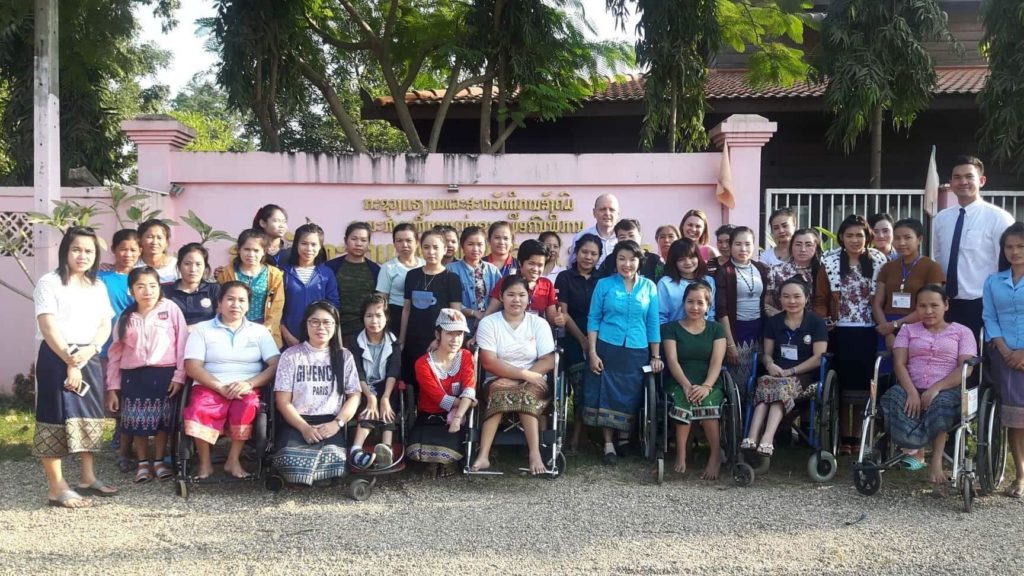
Aiming to enable the disabled, Lao Disable Women’s Development Center was established in 2022 as a non-profit organization run by women with disabilities. It is home to disabled women who come from all over the country to study and live. The center is set in a beautiful garden, on the banks of the Mekong River. It is where disabled women can gain life skills and vocational training so that they get empowered to live independent life. The site is open to the public and serves as a tourist site in Vientiane, in which visitors can learn about Laos culture, meet inspiring women, and provide their support if possible. The guided tours give donations that fund the center. It is open for visitors from Monday to Friday (from 09:00 AM to 4:30 PM) and by appointment over weekends. Groups and individuals are welcome. The center provides several tour options so that visitors can pick per their interest, such as the basic guided tour, handicraft class (60 minutes), tour with lunch, and basic Bacci ceremony (Bacci is an ancient Laos custom to tie holy cotton threads to bless the recipients), educational workshops, etc.
Vientiane Night Market
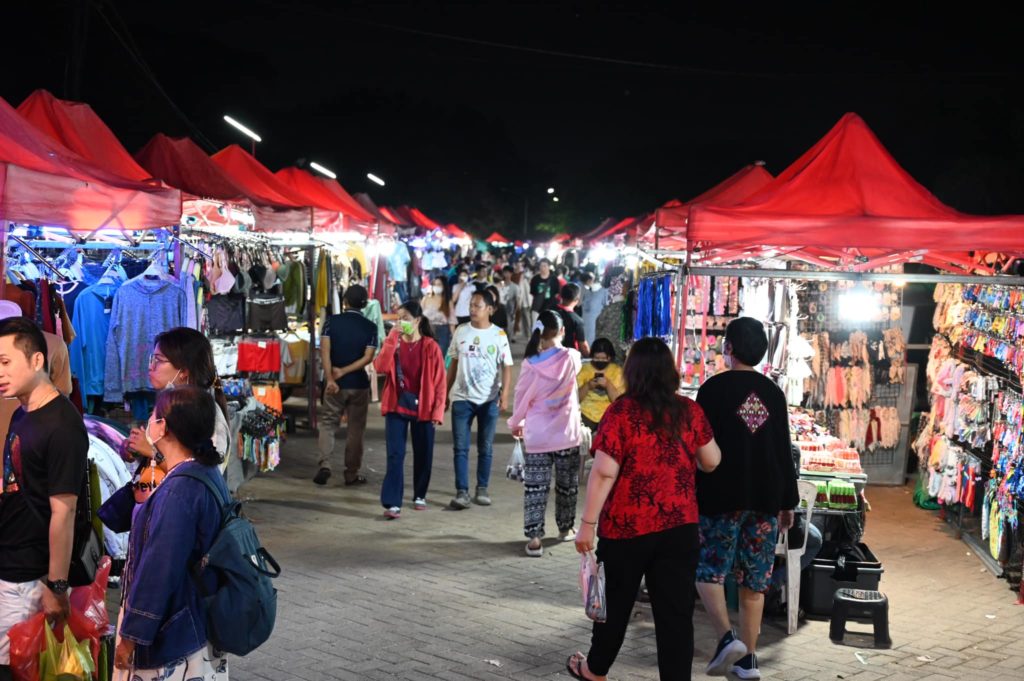
As a popular venue to feel Laos nightlife atmosphere, Vientiane Night Market is primarily organized to serve tourists. It begins around sunset when local vendors and merchants start setting up their red-roofed stalls on the riverside promenade. The riverside area of the Mekong River becomes alive with tourists and shoppers who are enjoying a cooling atmosphere, a beautiful view, and a shopping pastime. The reddish stalls make this market outstanding, and none will fail to recognize it. Products on sale vary from Lao skirts to textiles, handicrafts, footwear, sunglasses, technology gadgets, Buddha statues, Buddha paintings, etc. The dominant stalls mainly sell free-size dresses, skirts, and pants. The night market is a perfect address to practice your bargaining skills to seek the best deals. As usual, you can win between 10% and 30% discount. The amount of US$10 might bring you a couple of products in the market; try the Beer Lao T-shirts. It is a happy walking tour around the night venue, and the best time to get there is around 08:00 PM, but if you’re afraid of the crowd, it’s better to arrive a bit sooner. The market is open daily from 17:00 to 22:00, so monitor your arrival time.
The capital Vientiane should always be included in your Laos Tours as the city merely and Vientiane tourist attractions will keep you busy with what’s next to see on the agenda.

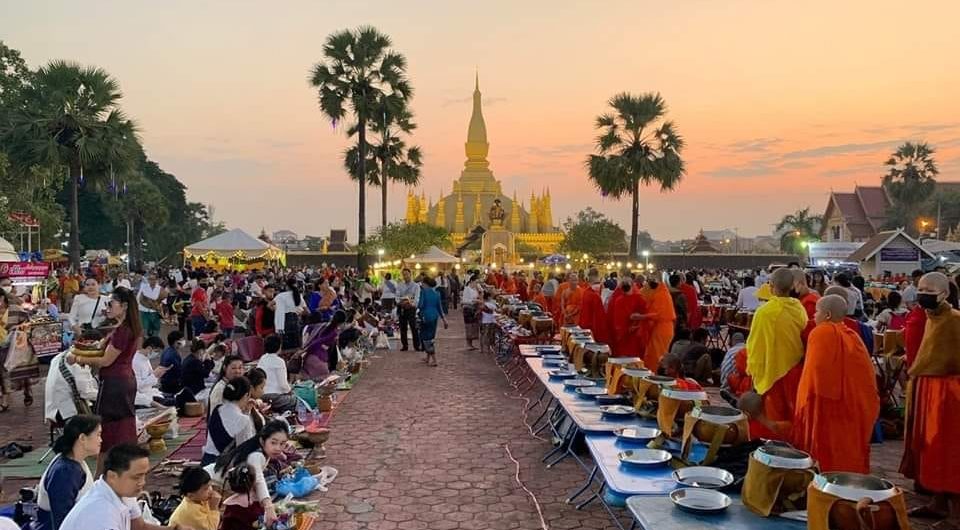
Comments